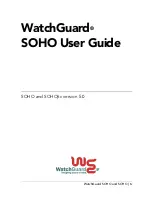
•
Allow the SITE EXEC command to be sent to an FTP server by a client.
•
Allow the RESUME command even if content scanning terminated the connection.
Note: Some commands are never allowed
Some commands, such as encryption instructions, are never allowed. Encryption
would mean that the FTP command channel could not be examined by the ALG and
the dynamic data channels could not be opened.
Control Channel Restrictions
The FTP ALG also allows restrictions to be placed on the FTP control channel which can improve
the security of FTP connections. These are:
•
Maximum line length in control channel
Creating very large control channel commands can be used as a form of attack against a server
by causing buffer overruns This restriction combats this threat. The default value is 256
If very long file or directory names on the server are used then this limit may need to be raised.
The shorter the limit, the better the security.
•
Maximum number of commands per second
To prevent automated attacks against FTP server, restricting the frequency of commands can be
useful. The default limit is 20 commands per second.
•
Allow 8-bit strings in control channel
The option determines if 8-bit characters are allowed in the control channel. Allowing 8-bit
characters enables support for filenames containing international characters. For example,
accented or umlauted characters.
Filetype Checking
The FTP ALG offers the same filetype verification for downloaded files that is found in the HTTP
ALG. This consists of two separate options:
•
MIME Type Verification
When enabled, NetDefendOS checks that a download's stated filetype matches the file's
contents. Mismatches result in the download being dropped.
•
Allow/Block Selected Types
If selected in blocking mode, specified filetypes are dropped when downloaded. If selected in
allow mode, only the specified filetypes are allowed as downloads.
NetDefendOS also performs a check to make sure the filetype matches the contents of the file.
New filetypes can be added to the predefined list of types.
The above two options for filetype checking are the same as those available in the HTTP ALG and
are more fully described in Section 6.2.2, “The HTTP ALG”.
Anti-Virus Scanning
6.2.3. The FTP ALG
Chapter 6. Security Mechanisms
252
Summary of Contents for NetDefend DFL-260E
Page 27: ...1 3 NetDefendOS State Engine Packet Flow Chapter 1 NetDefendOS Overview 27...
Page 79: ...2 7 3 Restore to Factory Defaults Chapter 2 Management and Maintenance 79...
Page 146: ...3 9 DNS Chapter 3 Fundamentals 146...
Page 227: ...4 7 5 Advanced Settings for Transparent Mode Chapter 4 Routing 227...
Page 241: ...5 4 IP Pools Chapter 5 DHCP Services 241...
Page 339: ...6 7 Blacklisting Hosts and Networks Chapter 6 Security Mechanisms 339...
Page 360: ...7 4 7 SAT and FwdFast Rules Chapter 7 Address Translation 360...
Page 382: ...8 3 Customizing HTML Pages Chapter 8 User Authentication 382...
Page 386: ...The TLS ALG 9 1 5 The TLS Alternative for VPN Chapter 9 VPN 386...
Page 439: ...Figure 9 3 PPTP Client Usage 9 5 4 PPTP L2TP Clients Chapter 9 VPN 439...
Page 450: ...9 7 6 Specific Symptoms Chapter 9 VPN 450...
Page 488: ...10 4 6 Setting Up SLB_SAT Rules Chapter 10 Traffic Management 488...
Page 503: ...11 6 HA Advanced Settings Chapter 11 High Availability 503...
Page 510: ...12 3 5 Limitations Chapter 12 ZoneDefense 510...
Page 533: ...13 9 Miscellaneous Settings Chapter 13 Advanced Settings 533...
















































